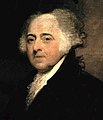Presidential election in the United States 1789
| ‹ 1789 • |
|||||||||||
| 1st presidential election | |||||||||||
| December 15, 1788 - January 10, 1789 | |||||||||||
|
|
|||||||||||
| Independently | |||||||||||
| George Washington / John Adams | |||||||||||
| electors | 69 | ||||||||||
| be right | 38,818 | ||||||||||
|
|
100% | ||||||||||
|
|
|||||||||||
| Election results by state | |||||||||||

|
|||||||||||
|
10 states
Washington / Adams |
|
||||||||||
|
|
|||||||||||
| President of the United States | |||||||||||
|
Before the election,
none |
|||||||||||
The US presidential election of 1789 was the first US presidential election and the only one that did not take place at the four-year cycle since 1792. The election took place after the ratification of the US Constitution in 1788. Polling stations opened on December 15, 1788, and closed on January 10, 1789. George Washington was elected first president and John Adams became the first vice president of the United States .
Before this election, the United States had no head of state in the strict sense of the word. The government consisted of the constitutional congress, headed by an official, and some executive departments, but there was no independent executive branch .
In this election, the hugely popular Washington ran almost unopposed. All other candidates who could have been elected president according to the regulations at the time, which lumped all electoral votes into one pot, supported Washington and only fought for the decision of the vice presidency. According to Article 2 of the American Constitution, every elector at that time cast two equal votes for the two candidates he preferred; as soon as a candidate had achieved a majority of the votes cast, he was elected president, and the runner-up became vice-president. It would have been possible for a vice-presidential candidate to receive the most votes, which is why the voting for Adams had to be tacted to prevent this. All 69 electors each cast one vote for Washington, the second votes were distributed among eleven candidates; John Adams got the most of these and became vice president. The 12th amendment to the Constitution of 1804 changed this procedure so that each elector could only cast one vote for completely separate elections for President and Vice-President.
The candidates
- John Adams , former Ambassador to Great Britain , from Massachusetts
- James Armstrong , Georgia politician
- George Clinton , Governor of New York
- Robert Hanson Harrison , Maryland judge
- John Hancock , Massachusetts Governor and former President of the Continental Congress
- Samuel Huntington , Connecticut Governor
- John Jay , US Secretary of State, from New York
- Benjamin Lincoln , Lieutenant Governor of Massachusetts
- John Milton , Secretary of State of Georgia
- John Rutledge , former South Carolina Governor
- Edward Telfair , former Georgia Governor
- George Washington , retired US Army Commander in Chief, of Virginia
The vote
| candidate | Political party | Home state | Popular election | electors | |
|---|---|---|---|---|---|
| number | percent | ||||
| George Washington | independent | Virginia | 38,818 | 100.0% | 69 |
| John Adams | federalist | Massachusetts | - | - | 34 |
| John Jay | federalist | new York | - | - | 9 |
| Robert Hanson Harrison | federalist | Maryland | - | - | 6th |
| John Rutledge | federalist | South carolina | - | - | 6th |
| John Hancock | federalist | Massachusetts | - | - | 4th |
| George Clinton | Anti-federalist | new York | - | - | 3 |
| Samuel Huntington | federalist | Connecticut | - | - | 2 |
| John Milton | federalist | Georgia | - | - | 2 |
| James Armstrong | federalist | Georgia | - | - | 1 |
| Benjamin Lincoln | federalist | Massachusetts | - | - | 1 |
| Edward Telfair | Anti-federalist | Georgia | - | - | 1 |
Since there were no conventions at the time, there was also no formal nomination process. The minds who wrote the constitution assumed Washington would become the first president, and after he returned from retirement and accepted his candidacy, there were no opposing candidates. He was therefore elected unanimously.
Only 10 of the then 13 states took part in this election. North Carolina and Rhode Island had not yet ratified the constitution and were therefore not allowed to participate. New York State did not designate any of its eight electors, as the state's parliament did not agree on an election process or candidates.
George Washington received 69 electoral votes and became the only president to date to win an election without a dissenting vote. In the 1792 election, two electors from Maryland and one from Virginia did not cast their votes. Only James Monroe managed to do something similar : in 1820 he received a single unauthorized dissenting vote, for which the elector in question was not authorized at all.
In order to avoid a possible tie between Washington and its eventual Vice-President John Adams , some electors, although they wanted Adams in that position, gave their second vote to another candidate.
Web links
Individual evidence
- ↑ a b The Electoral Count for the Presidential Election of 1789 ( Memento from September 14, 2013 in the Internet Archive )







